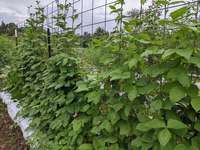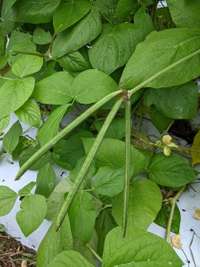Vigna vexillata is of African origin and is now common in Africa, Asia, the Americas, and the South Pacific (Panzeri et al., 2022). It is a perennial vine that grows along the ground or intertwines with and climbs other plants (Figure 14). V. vexillata produces an edible pulse and tuber. It is also grown as a forage and ground cover for controlling soil erosion. Common names for V. vexillata include Zombi pea, wild cowpea, and wild mung bean.

Figure 14. Climbing V. vexillata on a trellis. Source: Holly Sobetski
As a wild relative of cowpea (Vigna unguiculata), distinct collections of V. vexillata are used to try and improve cowpea grain productivity and quality, fodder quality, and resilience to pests, diseases, parasitic weeds like striga (Striga gesnerioides), and environmental stresses (Fatokun et al., 2000). Various researchers and plant breeders have tried unsuccessfully to hybridize and backcross V. vexillata traits into its food crop relative but cross incompatibility inhibits this (Boukar et al., 2020).
Climate and soil
V. vexillata grows in a wide range of climates (wet and dry tropics) under full sun to partial shade, up to 1500 m. Optimal conditions include temperature between 20° and 28°C and annual rainfall of1300 to 2100 mm (FAO 2024). Preferred soils are light (sandy loam) to medium textures (silt loam) with a depth of 50 to 150 cm and a soil pH range of 5.5 to 6.5 (FAO 2024). Of interest to plant breeders, for expanding the range over which the crop can be grown, are wild forms of V. vexillata that tolerate a broad range of conditions. Collections of indigenous V. vexillata from waterlogged lowlands to low rainfall regime (450 to 650 mm) show its adaptability to a wide range of conditions (Mapfumo et al., 2005).
Cultivation
Though cultivated less frequently than other beans with more established markets and agronomic research devoted to them, V. vexillata is an option worth trying in areas where other legumes may not thrive. Consider V. vexillata for its protein-rich tubers, for example, in places where there is not enough rainfall for sweet potato and cassava (Karuniawan et al., 2006). In a tuber production study, Priyadarsini et al. (2024) found the protein content in tubers and the mineral (phosphorus, calcium, zinc, magnesium, and iron) content of green pods was higher with a plant spacing of 60 x 30 cm than with closer spacings of 45 cm between rows and 15 cm or 30 cm in row. For taller vertical growth, support the vines with stakes or a trellis. The cropping cycle for V. vexillata is 180 to 270 days and its short-day photoperiod means long nights induce flowering. On-farm yields in Indonesia ranged from 18 to 30 t/ha for tubers and 0.7 to 1.2 t/ha for seeds (Karuniawan et al., 2006).
Pests
V. vexillata is susceptible to common pests that affect cowpeas but to a lesser extent. These are aphids (Aphis craccivora), flower thrips (Megalurothrips sjostedi), legume pod borer (Maruca vitrata [formerly M. testularis]), and a variety of pod sucking bugs (i.e., the green vegetable bug [Nezera viridula], the African Pod Bug [Clavigralla tomentosicollis], and the pod-sucking bug [Riptortus dentipes]). The cowpea weevil (Callosobruchus maculatus) is a pest of stored grain (Nabirye et al., 2003).
The soybean borer (Maruca vitrata) is controlled by Braconid parasitic wasps and Srinivasan et al. (2021) gives an Integrated Pest Management (IPM) plan with a list of regional parasitoids and predators of this pest. V. vexillata shows a high level of resistance to cowpea mild mottle virus (Betaflexiviridae: Carlavirus spp.).
Culinary and nutrition

Figure 15. Immature fruit (bean pods) of V. vexillata. Source: Holly Sobetski
V. vexillata leaves, young pods (Figure 15), seeds, and tubers are edible as food (NRC, 1979; Fern 2025). Young leaves and pods are cooked as a vegetable. The seeds are harvested dry and cooked as a pulse (dry bean). You can easily peel the skin of the tubers, the creamy flesh of which can be eaten raw, boiled, or roasted. The actively growing layer under the skin of the tuber (cambium) and the leaves are used to treat skin and gastrointestinal disorders by indigenous peoples in the South Pacific (Mazerand and Cock, 2020). The protein content in tuber roots of V. vexillata is about 15%, five-fold higher than that in sweet potato (Dachapak et al., 2018). Extracts of V. vexillata have been shown to have activity against bacteria, viruses, and inflammation (Leu et al., 2012; Mazerand and Cock, 2020).
References
Boukar, O., M. Abberton, O. Oyatomi, A. Togola, L. Tripathi, and C. Fatokun. 2020. Introgression Breeding in Cowpea [Vigna unguiculata (L.) Walp.] Frontiers in Plant Science. Vol. 11. https://doi.org/10.3389/fpls.2020.567425
Dachapak S., N. Tomooka, P. Somta, K. Naito, A. Kaga, and P. Srinives. 2018. QTL analysis of domestication syndrome in zombi pea (Vigna vexillata), an underutilized legume crop. PLoS ONE 13(12): e0200116. https://doi.org/10.1371/journal.pone.0200116
Fatokun, C.A., S.A. Tarawali, B.B. Singh, P.M. Kormawa, and M. Tamò (eds.). 2000. Challenges and Opportunities for Enhancing Sustainable Cowpea Production. Proceedings of the World Cowpea Conference III held at the International Institute of Tropical Agriculture (IITA), Ibadan, Nigeria, 4-8 September 2000. IITA, Ibadan, Nigeria.
Fern, K. 2025. Tropical Plants Database. tropical.theferns.info <tropical.theferns.info/viewtropical.php?id=Vigna+vexillata>
Food and Agriculture Organization (FAO) and IIASA. 2024. Vigna vexillata. ECOCROP, Global Agro-Ecological Zones version 4 (GAEZ v4) [Accessed 10 January 2025] URL: https://gaez.fao.org/pages/ecocrop-find-plant
Karuniawan, A., A. Iswandi, P.R. Kale, J. Heinzemann and W.J. Grüneberg. 2006. Vigna vexillata (L.) A. Rich. cultivated as a root crop in Bali and Timor. Genetic Resources and Crop Evolution (53:213-217.
Leu, Y.L., T.L. Hwang, P.C. Kuo, K.P. Liou, B.S. Huang, and G.F. Chen. 2012. Constituents from Vigna vexillata and Their Anti-Inflammatory Activity. International Journal of Molecular Sciences. Vol.13(8) 9754-9768. https://doi.org/10.3390/ijms13089754
Mapfumo, P., F. Mtambanengwe, K.E. Giller, and S. Mpepereki. 2005. Tapping indigenous herbaceous legumes for soil fertility management by resource-poor farmers in Zimbabwe. Agriculture, Ecosystems and Environment 109:221–233.
Mazerand, C. and I.E. Cock. 2020. The Therapeutic Properties of Plants Used Traditionally to Treat Gastrointestinal Disorders on Groote Eylandt, Australia. Evidence-Based Complementary and Alternative Medicine. 2438491. https://doi.org/10.1155/2020/2438491
Miller, I.L. and W.T. Williams. 1981. Tolerance of Some Tropical Legumes to Six Months of Simulated Waterlogging. Tropical Grasslands. Vol. 15 (1).
Nabirye, J., P. Nampala, M.W. Ogenga-Latigo, S. Kyamanywa, H. Wilson, H., V. Odeke, C. Iceduna, and E. Adipala. 2003. Farmer-participatory evaluation of cowpea integrated pest management (IPM) technologies in Eastern Uganda. Crop Protection 22(1), 31-38.
National Research Council. 1979. Tropical Legumes: Resources for the Future. Washington, DC: The National Academies Press. https://doi.org/10.17226/19836.
Panzeri, D., W. Nissim, M. Labra, and F. Grassi. 2022. Revisiting the Domestication Process of African Vigna Species (Fabaceae): Background, Perspectives and Challenges. Plants 11(4): 532. https://doi.org/10.3390/plants11040532
Priyadarsini, S., A. Nandi, M. Nedunchezhiyan, P. Choudhari, S. Singh and A. Pattnaik. 2024. Nutritional status of Zombi pea (Vigna vexillata) as influenced by plant density and deblossoming. Scientific Reports, 14(1), 3189.
Srinivasan, R., M. Tamò, and P. Malini. 2021. Emergence of Maruca vitrata as a Major Pest of Food Legumes and Evolution of Management Practices in Asia and Africa. Annual Review of Entomology. Vol. 66:141-161 https://doi.org/10.1146/annurev-ento-021220-084539